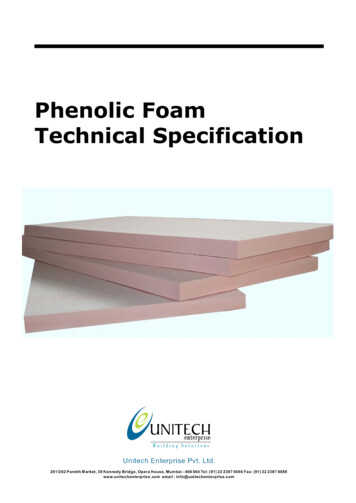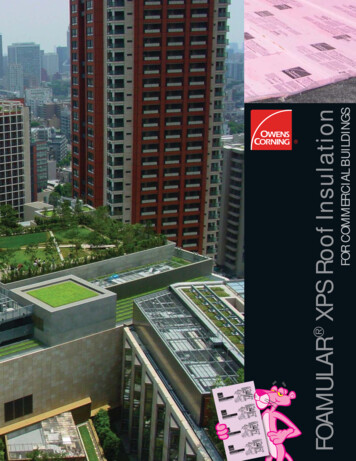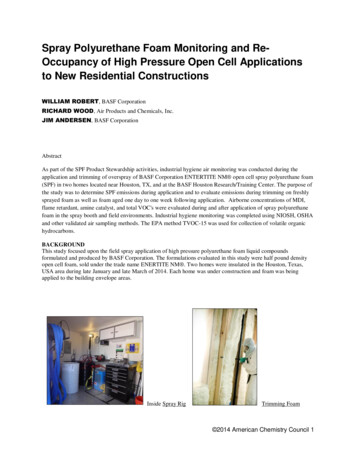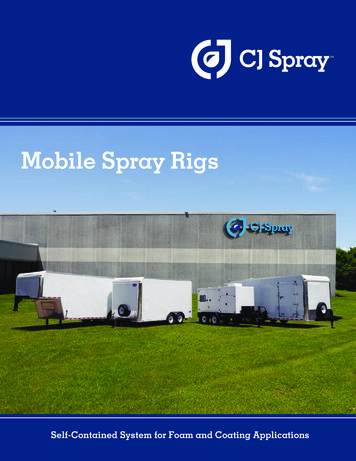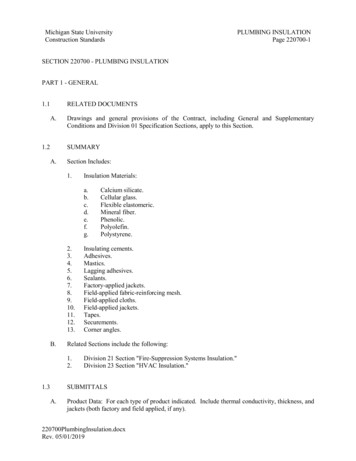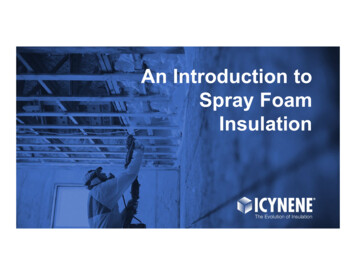
Transcription
An Introduction toSpray FoamInsulationICYNENE AND ITS PRODUCTSARE REGISTERED TRADEMAR KSOF ICYNENEINC.
Program RegistrationBNP Media is a registered provider with The American Institute of ArchitectsContinuing Education System. Credit(s) earned upon completion of this course will bereported to AIA CES for AIA members. Certificates of completion for both AIAmembers and non-AIA members are available upon request.This course is registered with AIA CES for continuing professional education. As such,it does not include content that may be deemed or construed to be an approval orendorsement by the AIA of any material of construction or any method or manner ofhandling, using, distributing, or dealing in any material or product.Questions related to specific materials, methods, and services will be addressed at theconclusion of this presentation.ICYNENE AND ITS PRODUCTSARE REGISTERED TRADEMAR KSOF ICYNENEINC.
Copyright Materials This presentation is protected by U.S. and international copyright laws.Reproduction, distribution, display, and use of the presentation without writtenpermission of the speaker is prohibited. Icynene 2017ICYNENE AND ITS PRODUCTSARE REGISTERED TRADEMAR KSOF ICYNENEINC.
Course OverviewOf all the different insulation options available today in commercial construction, spray foam canprovide outstanding thermal performance while also contributing to air sealing, moisture control, andeven structural integrity. This learning unit will provide an overview of spray foam insulation, how itdiffers from conventional insulation types, its most appropriate applications, and how the material isallowed to be used in fire-resistant construction.ICYNENE AND ITS PRODUCTSARE REGISTERED TRADEMAR KSOF ICYNENEINC.
Learning ObjectivesUponcompletion ofthis course, thestudent shouldbe able to:ICYNENE AND ITS PRODUCTSARE REGISTERED TRADEMAR KSOF ICYNENEINC. Explain the benefits of and thedifferences between open-cell sprayfoam insulation and closed-cell sprayfoam insulation. Describe the most appropriateapplications for open-cell and closedcell spray foam in commercial designs. Discuss how spray foam insulation canbe used in assemblies requiring fireresistance. Define the differences betweenthermal barriers and ignition barriers,and explain insulation fire ratings.
Section 1Spray Foam and Other Insulation TypesICYNENE AND ITS PRODUCTSARE REGISTERED TRADEMAR KSOF ICYNENEINC.
Common Types ofInsulationICYNENE AND ITS PRODUCTSARE REGISTERED TRADEMAR KSOF ICYNENEINC. Fiberglass Mineral wool Cellulose Rigid foam Spray foam
FiberglassICYNENE AND ITS PRODUCTSARE REGISTERED TRADEMAR KSOF ICYNENEINC. Made from melted sand/glass spun into fibers Batts and loosefill (blown-in) Noncombustible (unfaced and loosefill) Installation of batts can be labor intensive Faced batts include vapor retarder Performance depends heavily on properinstallation Not an air barrier material Compression of batts will reduce R-value
Mineral WoolICYNENE AND ITS PRODUCTSARE REGISTERED TRADEMAR KSOF ICYNENEINC. Made from melted stone or slag spuninto fibers Batts, loosefill, and rigid boards Noncombustible Installation of batts can be laborintensive Can be used as continuous(nonstructural) exterior insulation Not an air barrier material
Cellulose InsulationICYNENE AND ITS PRODUCTSARE REGISTERED TRADEMAR KSOF ICYNENEINC. Made from recycled newsprint or otherpaper products Treated with fire retardant Blown in as dry fiber or “damp sprayed” intocavities R-3.5 per inch Not an air barrier material
Rigid FoamInsulationICYNENE AND ITS PRODUCTSARE REGISTERED TRADEMAR KSOF ICYNENEINC. Used primarily on building exteriorsto provide continuous insulation Expanded polystyrene (EPS) Extruded polystyrene (XPS) Polyisocyanurate (Polyiso)
Rigid FoamInsulation ICYNENE AND ITS PRODUCTSARE REGISTERED TRADEMAR KSOF ICYNENEINC.Few rigid foam insulationproducts have been testedas part of an air barriersystem.
Spray FoamInsulationICYNENE AND ITS PRODUCTSARE REGISTERED TRADEMAR KSOF ICYNENEINC. Open cell (low density) andclosed cell (medium density) Tested air barrier material;superior air sealing High R-value possible Closed cell reduces bulk watermovement Manufactured at jobsite Wide range of applications
Section 2How Spray Foam Insulation WorksICYNENE AND ITS PRODUCTSARE REGISTERED TRADEMAR KSOF ICYNENEINC.
Spray Foam BasicsICYNENE AND ITS PRODUCTSARE REGISTERED TRADEMAR KSOF ICYNENEINC. Spray foam insulation becomes a final product onthe jobsite Truck-based spray rigs used to install highpressure spray foam Chemicals delivered in two separate 55-gallondrums (set) Chemical reaction between ISO and resin drums atspray gun results in foam creation
Blowing AgentsICYNENE AND ITS PRODUCTSARE REGISTERED TRADEMAR KSOF ICYNENEINC. Used to expand cells within foam Blowing agent for open cell foam iswater
Blowing AgentsICYNENE AND ITS PRODUCTSARE REGISTERED TRADEMAR KSOF ICYNENEINC. Some blowing agents for closed-cell foamhave high global warming potential (GWP) Lower GWP blowing agents are availableand are being adopted
Low-Density orOpen-Cell SprayFoamICYNENE AND ITS PRODUCTSARE REGISTERED TRADEMAR KSOF ICYNENEINC. Soft, flexible foam (density: 0.4to 0.75 pounds per cubic foot) R-value: R-3.7 to R-4.5 perinch Recognized as air barrier Interior applications only
Low-DensitySpray FoamApplicationsICYNENE AND ITS PRODUCTSARE REGISTERED TRADEMAR KSOF ICYNENEINC. Interior applications only Ceilings, wall cavities,unvented attics, floors, roof,and basement wall interiors Conforms to shape ofsubstrate
Medium-Densityor Closed-CellSpray FoamICYNENE AND ITS PRODUCTSARE REGISTERED TRADEMAR KSOF ICYNENEINC. Harder, rigid foam (density:2.0 to 2.4 pounds per cubicfoot) R-value: up to R-7.1 per inch Water-resistant barrier andair barrier Class II vapor retardertypically at 1.5 inch thickness Interior, exterior, and belowgrade applications
Medium-DensitySpray FoamApplicationsICYNENE AND ITS PRODUCTSARE REGISTERED TRADEMAR KSOF ICYNENEINC. Cavity insulation Continuous insulation Below grade and on buildingexteriors Better solution than rigid foamboard when installed oncurved surfaces
Dual ApplicationsWithin anAssemblyICYNENE AND ITS PRODUCTSARE REGISTERED TRADEMAR KSOF ICYNENEINC. Wall assemblies with bothopen-cell and closed-cellinsulation Achieve high R-values and airsealing with no thermal bridges Strategy limits moistureingress from exterior andinterior
Cost SavingsICYNENE AND ITS PRODUCTSARE REGISTERED TRADEMAR KSOF ICYNENEINC. Multiple functions in a singleapplication save materialand labor Open cell: thermal insulationand air sealing Closed cell: thermalinsulation, air sealing, waterresistant barrier, and vaporretarder
InstallationConditionsICYNENE AND ITS PRODUCTSARE REGISTERED TRADEMAR KSOF ICYNENEINC. Substrate must be dry andabove minimum specifiedtemperature Most common constructionmaterials suitable as substrate Spray foam components mustbe kept within specifiedtemperature range Closed-cell spray foaminstalled in accordance withpass thickness guidance
Section 3Spray Foam ApplicationsICYNENE AND ITS PRODUCTSARE REGISTERED TRADEMAR KSOF ICYNENEINC.
ContinuousInsulationICYNENE AND ITS PRODUCTSARE REGISTERED TRADEMAR KSOF ICYNENEINC. Commonly applies to exteriorof buildings but can occur onbuilding interior too Combines four functions in oneproduct (medium-density cellfoam) Adheres to curves and otherirregular shapes Adheres to most materialswithout a primer
ContinuousInsulation ICYNENE AND ITS PRODUCTSARE REGISTERED TRADEMAR KSOF ICYNENEINC.From a design standpoint,medium-density spray foamexpands the possibilities, as itcan adhere to curved,irregular, and unique shapesand conditions withoutcompromising its performance.In addition, medium-densityspray foam can adhere to mostcommon constructionmaterials without the use of aprimer.
ContinuousInsulation andThermal BridgingICYNENE AND ITS PRODUCTSARE REGISTERED TRADEMAR KSOF ICYNENEINC. Increases thermalperformance by eliminatingthermal bridging Spray foam creates uniformlayer with no joints/seams totreat Fully insulates around brickties and other attachments andpenetrations
Continuous Insulation and Thermal BridgingWhen applied as continuous exterior insulation, spray foam creates auniform layer with no joints or seams to compromise thermalperformance. Spray foam also completely insulates and seals aroundbrick ties and other attachments and penetrations to their full depth,ensuring full thermal performance and airtightness. In comparison, rigidfoam installations often require mechanical fasteners, which cancompromise the continuity and integrity of the insulation.Fitting rigid foam boards around penetrations must be donecarefully to ensure full performance.ICYNENE AND ITS PRODUCTSARE REGISTERED TRADEMAR KSOF ICYNENEINC.
Compatibilitywith OtherMaterialsICYNENE AND ITS PRODUCTSARE REGISTERED TRADEMAR KSOF ICYNENEINC. Cladding materials Transition membranes
Exterior ContinuousInsulation: Air-BarrierPerformanceICYNENE AND ITS PRODUCTSARE REGISTERED TRADEMAR KSOF ICYNENEINC. Medium-density spray foamtypically acts as an air barrierat 1 to 1.5 inches Few rigid foam board productstested Rigid foam board requiresealants, tape, or a membraneto be applied to cover jointsand gaps
Exterior ContinuousInsulation: WaterResistance Medium-density spray foam can serve as awater-resistive barrier (WRB) Rigid foam as WRB ICYNENE AND ITS PRODUCTSARE REGISTERED TRADEMAR KSOF ICYNENEINC.–Joints must be taped or sealed–Some rigid foams not rated as WRBIf insulation too vapor impermeable, wallmay not be able to dry to outside
Exterior ContinuousInsulation: WaterResistanceICYNENE AND ITS PRODUCTSARE REGISTERED TRADEMAR KSOF ICYNENEINC. Prevention of exterior watervapor into a wall is important,but if the wall is too vapor tightat its exterior, it may havetrouble drying to the outsideshould it become wet. Compared to other continuousinsulations, medium-densityspray foam typically provides awall with equal or greater dryingpotential to the outdoors, whichshould enhance durability andlongevity.
Unvented Atticsin Type V WoodFrame StructuresICYNENE AND ITS PRODUCTSARE REGISTERED TRADEMAR KSOF ICYNENEINC. Low-density or mediumdensity spray foam applied tounderside of roof deck Creates indirectly conditionedattic space Improves HVAC efficiency Temperature and humidityconditions usually close tooccupied space below
Basements, Foundations, and Below-Grade Walls Insulation and air barrier; helps prevent condensation Below grade: medium-density spray foam –Can be used in zones subject to flooding–Can serve as Class II vapor retarderLow-density spray foam allows wall moisture to dry more easilyICYNENE AND ITS PRODUCTSARE REGISTERED TRADEMAR KSOF ICYNENEINC.
Basements,Foundations, andBelow-Grade Walls ICYNENE AND ITS PRODUCTSARE REGISTERED TRADEMAR KSOF ICYNENEINC.Medium-density spray foam insulationis ideal for below-grade applicationsbecause it will not absorb moisture; infact, it may be specified by someauthorities (e.g. FEMA) to provideextra protection in areas where thereis a higher risk of flooding. It also canbe used as a Class 2 vapor retarderwhere required by the applicable code
UnventedCrawlspacesICYNENE AND ITS PRODUCTSARE REGISTERED TRADEMAR KSOF ICYNENEINC. Spray foam installed in wallsof crawlspace Improves HVAC efficiencyand protects pipes Improves energy efficiencyand indoor air quality
Section 4Fire Resistance andSpray FoamICYNENE AND ITS PRODUCTSARE REGISTERED TRADEMAR KSOF ICYNENEINC.
Fire Code Requirements All foam plastic insulation products including rigid board and spray foam are classified ascombustible materials. However, rigid foam board and spray foam insulation are commonly permitted withinnoncombustible assemblies once fire and safety code requirements have been met.ICYNENE AND ITS PRODUCTSARE REGISTERED TRADEMAR KSOF ICYNENEINC.
Fire Code Requirements NFPA 285 required for non-load bearing assemblies with foam plastics ASTM E119 (UL 263) required for fire resistance ratingICYNENE AND ITS PRODUCTSARE REGISTERED TRADEMAR KSOF ICYNENEINC.
Thermal BarriersICYNENE AND ITS PRODUCTSARE REGISTERED TRADEMAR KSOF ICYNENEINC. Half-inch gypsum wallboard ismost common prescriptiveapproach Wood panel products, sprayon fire-resistance coatings,and thermal blankets are alsooptions Many thermal barriers need tobe independently fire testedwith specific spray foamproduct
Ignition BarriersLess stringentthan thermalbarrierprimarilyrelated toresidential/wood framestructuresICYNENE AND ITS PRODUCTSRequired forcertainunoccupiedspaces, suchas attics andcrawl spacesARE REGISTERED TRADEMAR KSOF n(intumescent)coatingstypically used
Surface BurningCharacteristicsICYNENE AND ITS PRODUCTSARE REGISTERED TRADEMAR KSOF ICYNENEINC. Class B (required): SRI 75;SDI 450 Class A (optional): SRI 25;SDI 450
NFPA 285 ComplianceICYNENE AND ITS PRODUCTSARE REGISTERED TRADEMAR KSOF ICYNENEINC. Evaluates non-load bearing wall assemblieswith combustible materials Building Types I–IV in commercialconstruction Spray foam and rigid foam board insulation(buildings of any height) Air and water barriers and combustiblecladdings (buildings 40’ above grade)
NFPA 285 TestICYNENE AND ITS PRODUCTSARE REGISTERED TRADEMAR KSOF ICYNENEINC. Whole wall assembly is tested Passing criteria–Flames should notpropagate to second story–Temperatures should notexceed 1, 000 degreesFahrenheit
Tested Wall AssembliesMany assemblies with spray foam tested andapprovedEngineering judgements allow for designvariations to achieve complianceResources include manufacturers, QAI, ULEnvironmentICYNENE AND ITS PRODUCTSARE REGISTERED TRADEMAR KSOF ICYNENEINC.
ASTM E 119 TestICYNENE AND ITS PRODUCTSARE REGISTERED TRADEMAR KSOF ICYNENEINC. Measures fire resistance of anassembly Specimen subjected tocontrolled flame until failureoccurs
ASTM E 119 Test Assemblies classified basedon time expired beforefailure Several spray foammanufacturers have testedtheir products in fireresistance assembliesICYNENE AND ITS PRODUCTSARE REGISTERED TRADEMAR KSOF ICYNENEINC.
ConclusionThank you for your interest in the benefits ofopen- and closed-cell spray foam insulation.This concludes the American Institute of Architects ContinuingEducation Systems Course.Please visit www.icynene.com if you have any questions aboutthe material presented ENE AND ITS PRODUCTSARE REGISTERED TRADEMAR KSOF ICYNENEINC.
Spray Foam B asics Spray foam insulation becomes a final product on the jobsite Truck-based spray rigs used to install high-pressure spray foam Chemicals delivered in two separate 55-gallon drums (set) Chemical reaction between ISO and resin drums at spray gun results in foam creation


